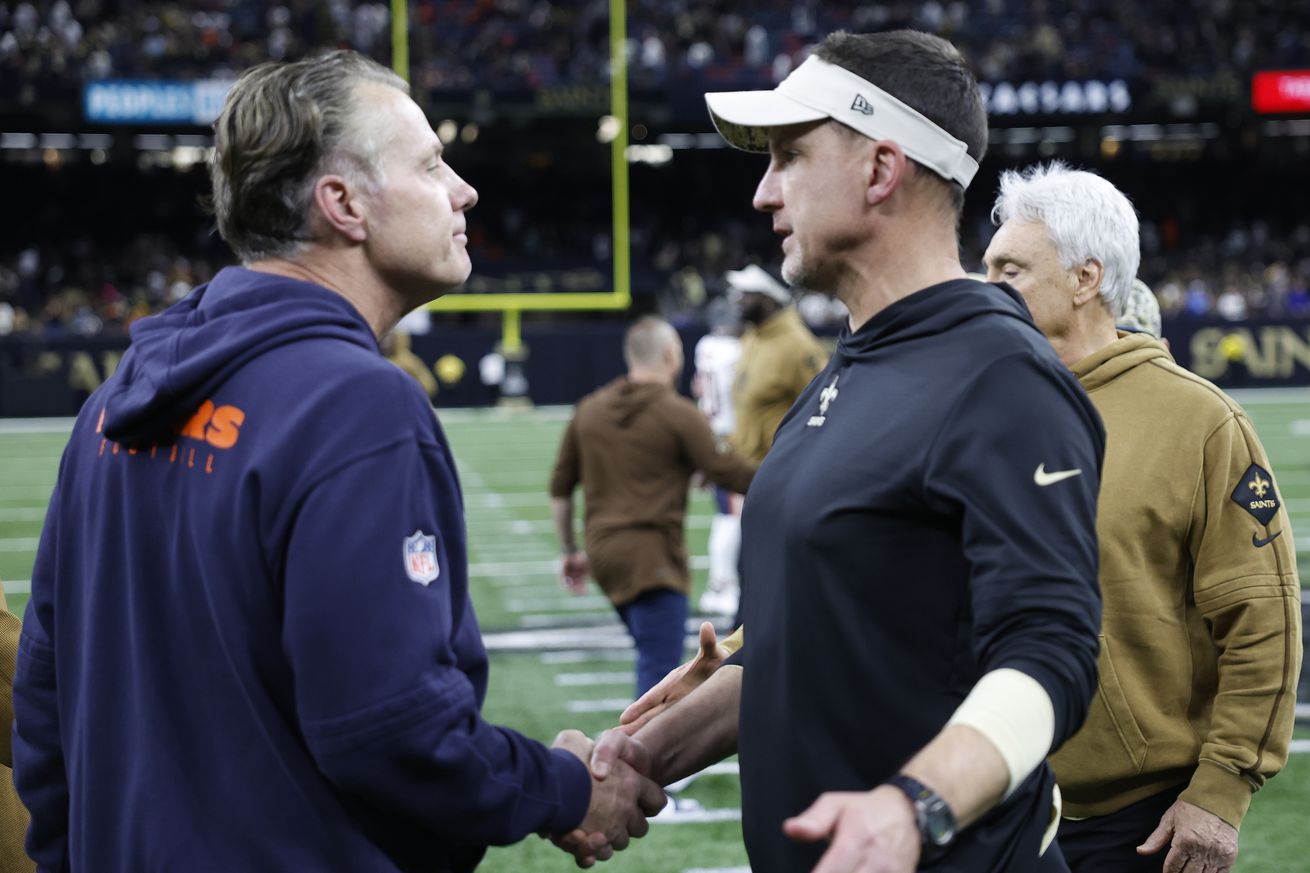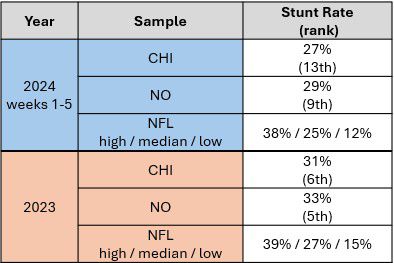
The Chicago Bears changed out Matt Eberflus for Dennis Allen as the man calling defensive plays this offseason. Both men run a base 4-3 defense, with 4 defensive linemen and 3 linebackers, but their defensive styles are quite different. Today, I want to dig into the data to see what we can expect to see stay the same or change quite a bit compared to Chicago’s 2024 defense.
Personnel
Let’s start with a basic look at how many players from each position are on the field each snap. The table below shows that data for both the New Orleans Saints and the Bears across the 2023 and 2024 seasons (data from Pro Football Reference).

A few thoughts:
- Let’s start with the one clear similarity: both coordinators like to pull a DT off the field and replace it with a DE roughly 20% of the time (as evidenced by 2.2 DE/snap and 1.8 DT/snap instead of the assumed 2/snap in a standard 4-3 look). That presumably happens on passing downs to help provide some extra pass rushing juice.
•I will be curious to see if that trend continues in Chicago this year since Chicago has significantly better depth at DT than DE. It’s highly possible the Bears decide that leaving 2 of Grady Jarrett, Gervon Dexter, or Shemar Turner on the field gives them a better pass rush than replacing one of those with a backup DE like Austin Booker or Tanoh Kpassagnon.
- One clear difference is in the number of LB on the field. Eberflus’ defenses use more of them.
•The Eberflus defense was extremely vanilla in 2024. They played only 16 snaps that were not in a base (4 DL, 3 LB, 2 CB, 2 S) or nickel (4 DL, 2 LB, 3 CB, 2 S) look. Those were their 2 packages, and they ran nickel roughly 80% of the time, which is why they averaged 2.8 CB (2 CB in base, 3 in nickel) and 2.2 LB (3 LB in base, 2 in nickel) per snap.
•Allen’s defense will use a lot of different looks in sub packages, which is why the LB, S, and CB numbers are different from Chicago’s. For starters, they run a lot more dime packages, where they have now 6 DBs on the field, usually to go along with only 1 LB. This was Allen’s base defense on 3rd down in 2024, and has been heavily used against pass-heavy teams going back to at least 2020. We have already heard reports from camp that Chicago’s defense is utilizing dime packages significantly more than they did the last few years, and we should expect that to continue into the regular season.
•We can tell from the S and CB data that sometimes the extra defensive back in dime looks is a safety, while other times it is a CB. Notice Chicago was at exactly 2.0 safeties/snap, while NO was above that, indicating they had a 3rd S on some plays). I am uncertain how frequently this will happen in Chicago given that Allen is not bringing versatile safety Tyrann Mathieu with him, but he has talked some about wanting to use safety Jaquan Brisker in a wider variety of ways, so perhaps that will lead to some 3 safety looks where Brisker is playing more of a snap CB or LB role. Otherwise, it seems likely Chicago’s main chess piece in the secondary will be nickelback Kyler Gordon, who should see a much more diverse role than he has had the last 2 years.
Coverage
Next, I want to examine how Chicago’s pass coverage might change going from Eberflus to Allen.
Expect more man
The first thing, which you’ve probably heard before, is that Allen will run significantly more man coverage. I wanted to put some actual numbers on this for context, because it’s not all or nothing (data from PFF).

This data is from 2024, but the numbers for Chicago and New Orleans’ defenses were essentially the same in 2023. Allen runs man coverage about twice as often as Eberflus did, but the majority of the time is still zone. Now, Chicago should expect to be in man about 1⁄3 of the time, whereas it was about 1/6 under Eberflus.
Changes in Zone Coverage
What those coverages look like in zone will vary quite a bit as well. This source shows that the 2024 Bears predominantly relied on cover 3 (with 3 deep zones to try to keep things underneath) when in zone, running it about 3x as often as man coverage (mostly cover 1) cover 2, or cover 4. The Saints, on the other hand, ran pretty even amounts of man (cover 1), cover 2, and cover 3. So not only should we expect to see the Bears run more man coverage under Allen, we should also anticipate a more even split of coverage types when they are in zone.
Tweaks to Slot Coverage
We’ll also see a difference in who gets asked to cover the slot, as you can see in the table below.

Generally, Allen has more CB and S cover the slot more frequently, which means LB cover the slot less often. That makes sense considering we saw above Allen will utilize dime packages – which remove a LB and add a S or CB – significantly more often than Eberflus did. This hopefully should help the pass defense, since S and CB should generally be better in coverage than LB are.
Generating Pressure
Lastly, I want to examine how each coordinator approaches generating pressure on the quarterback.
Not much blitzing
The first thing to note is that neither coordinator likes to blitz much. Per Pro Football Reference, Chicago blitzed 24% of the time in 2024, which ranked 19th in the NFL, while New Orleans blitzed 21% of the time, ranking 24th. Both were below the NFL average of 25%, and that trend was consistent in 2023 (Chicago 22%, New Orleans 23%) and 2022 (Chicago 18%, New Orleans 17%) as well. Obviously, you can see blitz rates vary a bit from year to year, but you shouldn’t expect Chicago to suddenly become blitz-happy under Allen.
It is worth noting that Allen likes throwing a lot of bodies on the line of scrimmage to make it look like he is blitzing, especially on passing downs, before dropping back into coverage. This can be a way of trying to confuse the opposing QB without leaving yourself exposed in coverage by rushing a lot of bodies.
Tweaks to who is blitzing
One slight difference when the Bears do blitz will be in who blitzes, as you can see in the table below.

The biggest difference here is that Allen blitzed his safeties about as often as his CB, while Eberflus mostly used his CB (mainly nickelback) for blitzes from the secondary. I’m curious to see how much this translates to Chicago, as it could be based more on personnel. Kyler Gordon is a really good blitzer, so maybe Allen wants to lean into that like Eberflus did, but we have seen above that he puts more safeties on the field than Eberflus, so it’s highly possible that translates to more safeties blitzing as well.
Slightly more stunting
One other thing to note is how frequently the defensive line stunts, or has 2 defensive linemen exchange rush lanes. Data on this is less publicly available, but I was able to find it from PFF for all of 2023 and the first 5 weeks of 2024. That data is shown in the table below.

Here you can see that both Eberflus and Allen like to stunt more than average, though Allen generally stunts at a slightly higher rate. Given that he doesn’t blitz a ton and the Bears don’t have a great collection of pass rushers, I anticipate that continuing to Chicago. The Bears finished 2024 generating a pressure on almost 49% of their stunt rushes, the 4th highest mark in the NFL, and I will be curious to see if that success continues in 2024. They generated a pressure on only 34% of stunts in 2023, the worst mark in the NFL, so I don’t think it was an Eberflus stat, but I’m not sure how much of it was personnel-driven vs. small sample size fluke.
Lessons Learned
Here’s a nice, quick summary of the main takeaways from today’s article about what should stay the same vs. change from Eberflus to Allen:
- Same: replace a DT with a DE on passing downs, not much blitzing, lots of stunts
- Different: about twice as much man coverage, more even mix of cover 2/cover 3 in zone, more dime looks (more CB/S and fewer LB on the field on passing downs).
Overall, we should see a more diverse defense than Eberflus’ fairly standard approach of the last 3 years, and I am excited to see how that works with Chicago’s personnel.
